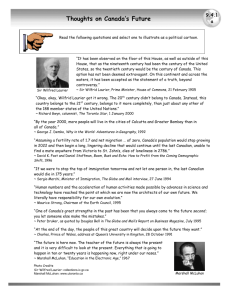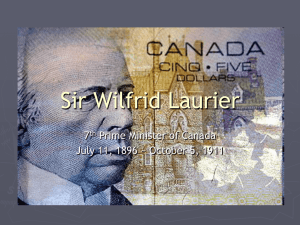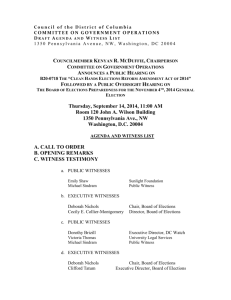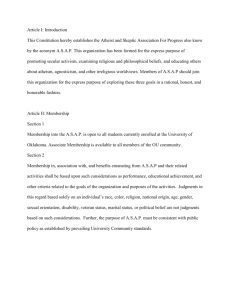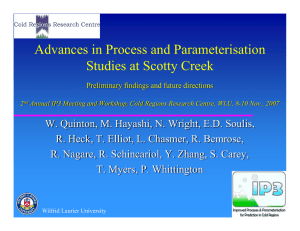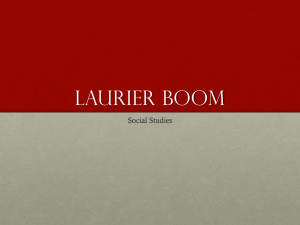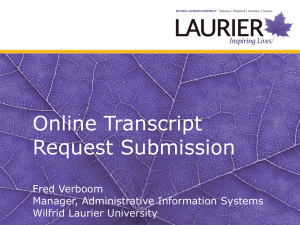Conférences de D. Marc Kilgour Université Paul
advertisement
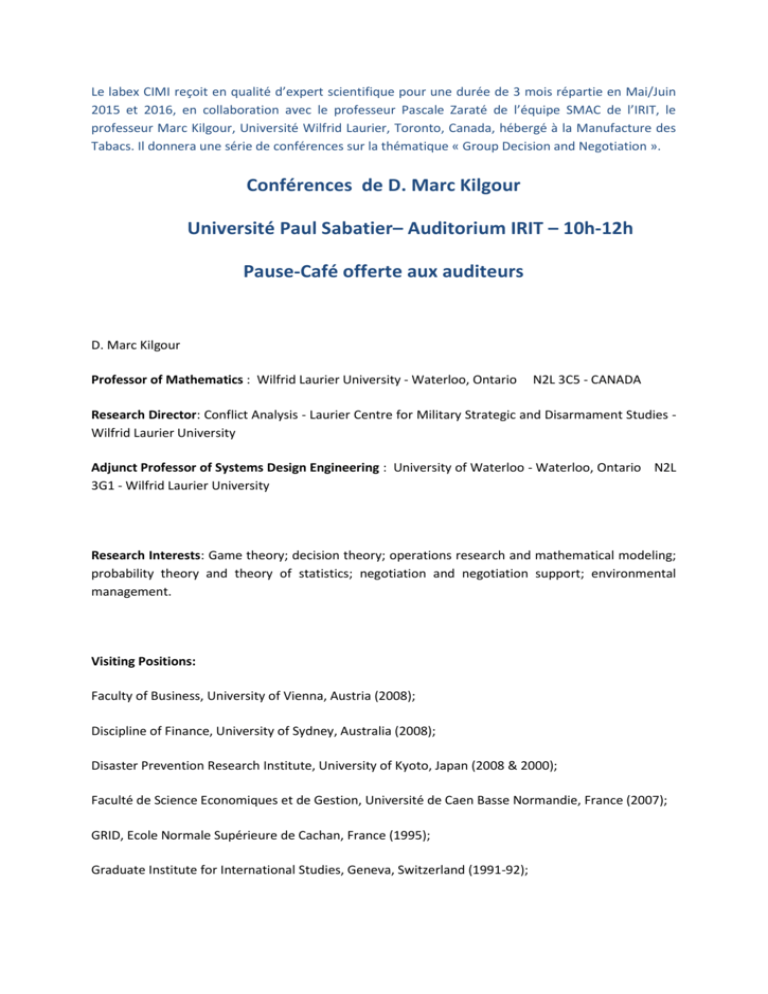
Le labex CIMI reçoit en qualité d’expert scientifique pour une durée de 3 mois répartie en Mai/Juin 2015 et 2016, en collaboration avec le professeur Pascale Zaraté de l’équipe SMAC de l’IRIT, le professeur Marc Kilgour, Université Wilfrid Laurier, Toronto, Canada, hébergé à la Manufacture des Tabacs. Il donnera une série de conférences sur la thématique « Group Decision and Negotiation ». Conférences de D. Marc Kilgour Université Paul Sabatier– Auditorium IRIT – 10h-12h Pause-Café offerte aux auditeurs D. Marc Kilgour Professor of Mathematics : Wilfrid Laurier University - Waterloo, Ontario N2L 3C5 - CANADA Research Director: Conflict Analysis - Laurier Centre for Military Strategic and Disarmament Studies Wilfrid Laurier University Adjunct Professor of Systems Design Engineering : University of Waterloo - Waterloo, Ontario N2L 3G1 - Wilfrid Laurier University Research Interests: Game theory; decision theory; operations research and mathematical modeling; probability theory and theory of statistics; negotiation and negotiation support; environmental management. Visiting Positions: Faculty of Business, University of Vienna, Austria (2008); Discipline of Finance, University of Sydney, Australia (2008); Disaster Prevention Research Institute, University of Kyoto, Japan (2008 & 2000); Faculté de Science Economiques et de Gestion, Université de Caen Basse Normandie, France (2007); GRID, Ecole Normale Supérieure de Cachan, France (1995); Graduate Institute for International Studies, Geneva, Switzerland (1991-92); Department of Systems Design Engineering, University of Waterloo (1984-85). Awards / Distinctions: 2014 President Elect, INFORMS Section on Group Decision and Negotiation 2013 Awarded the 2012 Elinor Ostrom Prize for the best paper in the Journal of Theoretical Politics. This paper, titled “Narrowing the Field in Elections: The Next-Two Rule,” was co-authored with Steven J. Brams of New York University. The citation called the article “a masterpiece of clarity,” and “a source of inspiration for much future work in this important area of political science.” The award was presented 29 August 2013. 2011-12 President, Peace Science Society (International) 2010 Named “Distinguished Visitor and Member of NUAA,” by Nanjing University of Aeronautics and Astronautics, Nanjing, China, 30 March 2010. 2007 Received INFORMS GDN Section Award at GDN 2007, Mont Tremblant, QC. 2001 Named Fellow, ZiF (Zentrum für interdisziplinäre Forschung, Universität Bielefeld, Germany) Research Group on Procedural Approaches to Conflict Resolution. 1996 Named Collaborating Researcher, IIASA (International Institute of Applied Systems Analysis) Project on Decision Analysis and Support (DAS). 1995 Named Distinguished Associate of the Martin Institute for Peace Studies and Conflict Resolution, University of Idaho, USA. 1994 Named to MAS Honor Roll by Military Applications Section of ORSA (Operations Research Society of America). 1990 Named University Research Professor for 1990-91 by Wilfrid Laurier University. 1989 Nominated for Phi Sigma Alpha Award for 1989. 1986 Received R. Duncan Black Award for 1984. Conference 1: Graph Model for Conflict Resolution Wednesday 20th May The Graph Model for Conflict Resolution: Past, Present, and Future (2 hours) Conflict Analysis is a set of principles and techniques to model and analyze strategic conflicts, or multi-person, multi-objective decision problems. These game-theory-related techniques are all based on the principle that actors are purposive. Among them, the Graph Model for Conflict Resolution stands out for the simplicity and flexibility of its models and the breadth of its analysis. This presentation shows the remarkable development of the Graph Model since its first publication in 1987. The graph model system is prescriptive, aiming to provide a specific decision-maker with useful strategic insights. The basics of the Graph Model are described in detail, using real-life conflicts as illustrations. Then more recent developments are discussed, including added flexibility in modeling, including multi-level preference and uncertain, fuzzy, and grey preference, new analysis techniques using matrix methods, the development of post-analysis procedures, including coalition analysis and status quo analysis Inverse GMCR, a procedure that can advise disputants and mediators. The newest Decision Support System, GMCR+, with its strong visualization components, will be used to illustrate these ideas. A brief look to the future will show that the next generation of decision support based on the Graph Model will be even more comprehensive and even more powerful. Friday 22th May Applications of Model for Conflict Resolution (2 hours) Conference 2: Fair Division Tuesday 2nd June Fair Division: Old and New (2 hours) Often, group decision and negotiation can be broken down into two processes: helping the parties share some information about their preferences, and then using this information to find a “fair” allocation. But what makes an allocation fair? One fairness criterion is envy-freeness: An allocation is envy-free if each participant feels that his or her portion is at least tied for best – and therefore does not envy anyone else. With such a criterion in mind, then we can ask how to use information about preferences to find a fair allocation. Is it always possible? Can the parties do it themselves, or is a central authority necessary? A prototype procedure for fair division between two persons is “I Cut, You Choose,” (ICYC) for splitting a divisible (continuous) good between two people. ICYC is assessed, and various improvements and extensions introduced. ICYC also lies at the heart of some new procedures for the allocation of indivisible items, particularly in situations with very limited information about preferences. One special case has been identified in which there is an elegant, easy-to-compute solution. Fair division algorithms and principles are related in a fundamental way to procedural approaches to allocation and interest negotiation, and can be applied to problems in economics, computer science, operations research, management, and politics. Conference 3: Voting Procedures Tuesday 16th June An Overview of Voting and Elections (2 hours) Voting, a commonly used group-decision process, usually aims to aggregate decision recommendations in a way that is appropriate and balanced. The “cornerstone of democracy” is the opportunity to vote in a free, fair, and open electoral system. In fact, a multitude of electoral systems has been proposed, most to choose a single winner (as in the election of a mayor, governor, or president), but some to determine multiple winners (as in the election of a committee). Many desirable properties for group-decision procedures have been formulated. Looking at the mathematics behind the various electoral systems, we assess their abilities to achieve these properties. No system achieves them all, and it seems very unlikely that anything close to a perfect system will ever be invented. Thus the choice of a voting system seems to come down to tradeoffs, which themselves are difficult to assess. Yet there has been some progress toward making voting and elections, as group-decision processes, responsive, transparent, and fair. Friday 19th June Multi-Winner Elections Using Approval Balloting (2 hours) Multi-winner elections are becoming more common, perhaps reflecting the ubiquity of the internet and the growing ability to handle massive datasets. Approval balloting is a natural choice for multiwinner elections, and many procedures based on it have been proposed, often adapted from singlewinner election procedures. One interesting issue is the composition of the set of winners; in the simplest case (called FNW, or Fixed Number of Winners), the size of the winning subset is fixed in advance. Another possibility is a VNW (Variable Number of Winners) election, in which the voters themselves to determine how many win, as well as who wins. A recent survey of procedures for multi-winner elections is reviewed. Then some properties applicable to FNW elections are discussed briefly. Finally, some possible axioms for VNW elections are proposed and shown to imply a new procedure.
